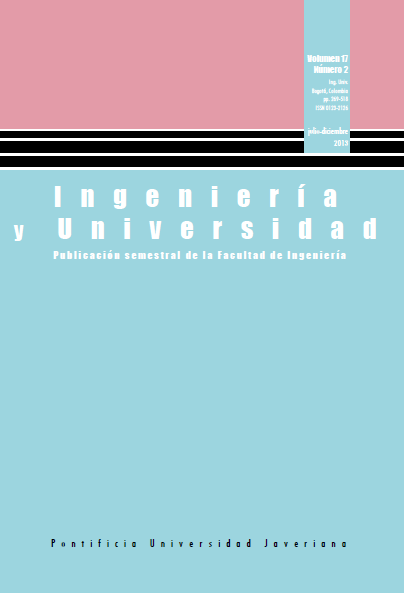Abstract
In this paper we propose the formulation of a model for urban double travel distribution delimited at origin and destination, based on the maximization of entropy and minimization of the generalized travel costs by relaxing the condition that such costs are a parameter, extending the formulation under the assumption that they are fuzzy variables with an intervalar function. In addition, given such assumptions, we propose a formulation of an optimization model associated with discrete choices, and we present a proposal for using the model in predictions. A numerical example is developed for explaining the theory developed.
DELL`ORCO, M. y KIKUCHI, S. An alternative approach for choice models in Transportation: use of possibility theory for comparison of utilities. Yugoslav Journal of Operations Research. 2004, vol. 14, núm. 1, pp. 1-17
FANG, S.; RAJASEKERA, J. y TSAO, H. Entropy Optimization and Mathematical Programming. Norwell, MA: Kluwer Academic Publishers, 1997.
LÓPEZ, H. Introducción a GAMS y su aplicación en la solución de modelos matemáticos de optimización. Cuadernillo cursillo XXII Coloquio distrital de Matemáticas y estadística. Bogotá: Universidad Nacional de Colombia, Departamento de Matemáticas, 2006.
MARTÍNEZ, F. Access, the Economic Link in Transport-Land Use Interaction. Transportation Research B. 1995, vol. 29, núm. 6, pp. 457-47.
MARTÍNEZ, F. y ARAYA, C. Note on Trip Benefits in Spatial Interaction Models. Journal of Regional Science. 2000, vol. 40, núm. 4, pp. 789-796.
MOMENI, H. Y NAZEMI, J. A fuzzy-random Utility Model of Consumer Choice; Uncertainty Effect. World Applied Sciences Journal. 2010, vol. 8, núm. 10, pp. 1183-1192.
ORTÚZAR, J. y WILLUMSEN, L. Modelos de transporte. Santander: Publican, Ediciones de la Universidad de Cantabria, 2008.
ROMERO, J. Notas sobre Máxima Entropía. Documento de trabajo. México: UNAM Facultad de Ciencias, 2008.
ROMIK, D. Stirling’s Approximation for n!: The Ultimate Short Proof? The American Mathematical Monthly. 2000, vol. 107, núm. 6, pp. 556-557.
SHANNON, C. E. A mathematical theory of communication. Bell System Technical Journal. 1948, vol. 27, pp. 379-423 y 623-656.
WANG, X. y XIAO, M. Approach of group decision making based on normal distribution interval number with incomplete information. Journal of Control and Decision. 2010, vol. 10. 1494-1498.
WILSON, A. G. Entropy in urban and regional modeling. London: Pion, 1970.
This journal is registered under a Creative Commons Attribution 4.0 International Public License. Thus, this work may be reproduced, distributed, and publicly shared in digital format, as long as the names of the authors and Pontificia Universidad Javeriana are acknowledged. Others are allowed to quote, adapt, transform, auto-archive, republish, and create based on this material, for any purpose (even commercial ones), provided the authorship is duly acknowledged, a link to the original work is provided, and it is specified if changes have been made. Pontificia Universidad Javeriana does not hold the rights of published works and the authors are solely responsible for the contents of their works; they keep the moral, intellectual, privacy, and publicity rights.
Approving the intervention of the work (review, copy-editing, translation, layout) and the following outreach, are granted through an use license and not through an assignment of rights. This means the journal and Pontificia Universidad Javeriana cannot be held responsible for any ethical malpractice by the authors. As a consequence of the protection granted by the use license, the journal is not required to publish recantations or modify information already published, unless the errata stems from the editorial management process. Publishing contents in this journal does not generate royalties for contributors.


